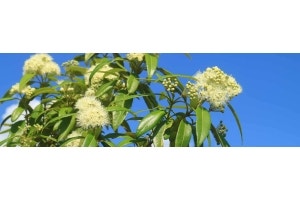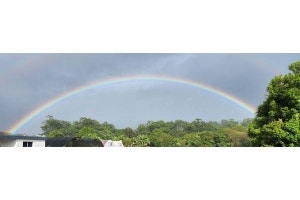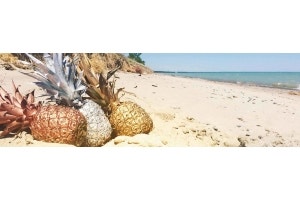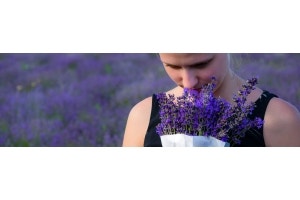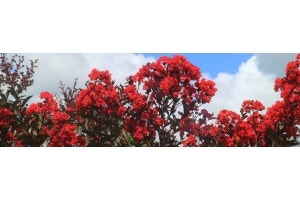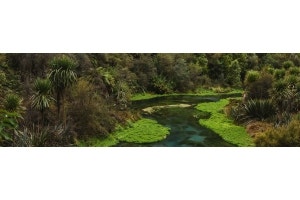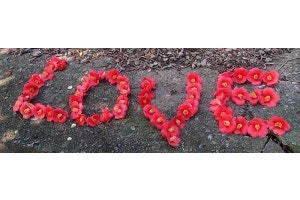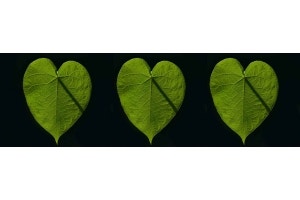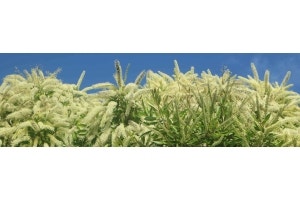
Calming Green Texture in a Simple Planting Plan

Above is a closeup of our stand display at the 2021 Queensland Garden Expo. You can see more of the display in the smaller image here.
Our packaging manufacturer even built a giant cardboard box planter for us, to match our plant packaging! The display was much admired, and photographed, and fondled - those fluffy little mounds are irresistible to stroke...
Many visitors asked us how to reproduce it at home. Here, we show you how you can recreate the look of our giant box planter garden, in your own back yard.
Four Plants, One Big Planter
It looks impressive but is very simple to copy, with only four kinds of plants, and a clean minimal planting plan. You can plant into a giant container, as we did, or straight into the ground to create a feature bed. It's up to you!

1. Tristaniopsis - native water gum
First, plant a native water gum - Tristaniopsis laurina Luscious - in the centre of your planter or garden bed, as a feature tree. Native water gum, or kanooka, has glossy leaves, bright apple-green when new, and clusters of small golden-cream spring flowers. This variety, Luscious, has bigger broader leaves than the species form, and is a more compact size for smaller gardens.
We used a mature size tree for instant impact at the show.
You can plant our tubestock trees straight out into your garden beds. They may look small now but in a year or two they will develop a woody trunk and plenty of side branches. Best of all, you don't need to dig a big hole, or stake them.

2. Sagina - moss
Once the tree is in place, surround the base of the trunk with a geometric carpet of Irish moss - Sagina - to give the effect of a lush lawn beneath the tree. The moss is soft and springy to touch, and spreads widthways to form a green carpet. It's an excellent lawn alternative for areas of your garden that don't get a lot of traffic.We placed our tubestock pots side by side, fitted tightly into the planter box, to produce an instant lawn effect. When you plant them in your garden you'll need fewer plants, as you can space them further apart with plenty of room for them to spread out and grow. Work out how many plants you need to cover the area with our blog post here.
Irish moss is a deep emerald green; you could swap it for golden Scotch moss, which has a softer fluffier leaf, and a bright lime green tone.
You can see the two side by side here - Scotch on the left, Irish on the right.

3. Festuca glauca - blue fescue
Next, plant a ring of fine-leaved blue fescue grass - Festuca glauca - around the edge of the Irish moss plants.This will give you a contrast in texture to the rounded hummocks of moss, and a contrast in shades of green.
Blue fescue is deep blue-green when grown in shade, and brighter steel blue in sunshine. You can see the steel blue colour in the second image here.
The plants stay compact and have a rounded shape which echoes that of the moss.
For an even stronger contrast in colour, swap the green-blue Festuca glauca for the icy-blue Festuca Elijah Blue, a new variety which has a much brighter lighter colour.Korean velvet grass, (aka no-mow grass) - Zoysia - will give you a similar look, slightly smaller and grassier than fescue, and like the moss, you won't have to mow it.For a bolder contrast in texture, with the same blue-green tones, plant Carex Blue Cascade - broader-leaved than fescue, and just as compact. Carex grows in a fountain shape, which will attractively cascade over the edges of a planter.

4. Viola hederacea - native violet
For the finishing touch, in a border around the edge of the moss and fescue, create a frame of purple and white native violets - Viola hederacea - which flower readily even at small tubestock size. Their dainty heart-shaped leaves contrast with the fine blades of fescue grass and the soft fronds of moss. Like the moss, they will grow to cover a broader area, so you won't need to plant them as tightly together as we did. Violas will love the shade created by the tree, but will grow in full sun too if they have enough water.
 Plant a mix of viola Baby Blue, an all-purple-blue native violet in a beautiful soft shade, and viola Rosina (shown here), a warm pink native violet with larger leaves than the other two, for an extended flowering season to your design.
Plant a mix of viola Baby Blue, an all-purple-blue native violet in a beautiful soft shade, and viola Rosina (shown here), a warm pink native violet with larger leaves than the other two, for an extended flowering season to your design.
And that's it!
Remember to water your new tubestock regularly until the plants are established, and water them afterwards in very warm or sunny weather to keep them looking lush and green.





















